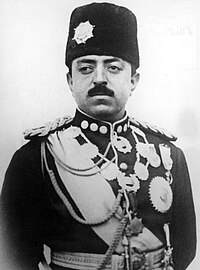Amanullah Khan
This article needs additional citations for verification. (October 2009) |
| Amanullah Khan | |
|---|---|
| King of the God granted Kingdom of Afghanistan and its dependencies[1] | |
 | |
| Reign | February 28, 1919 - January 14, 1929 |
| Predecessor | Nasrullah Khan |
| Successor | Inayatullah Khan |
| Father | Habibullah Khan |
| Mother | Sarwar Sultana Begum |
Amanullah Khan (Pashto: أمان الله خان ) (June 1, 1892 – April 25, 1960) was the ruler of the Emirate of Afghanistan from 1919 to 1929, first as Amir and after 1926 as Shah.[2] He led Afghanistan to independence over its foreign affairs from the United Kingdom, and his rule was marked by dramatic political and social change.
Amanullah Khan was the third son of the Amir Habibullah Khan. Amanullah was already installed as the governor of Kabul and was in control of the army and the treasury, and gained the allegiance of most of the tribal leaders.
Russia had recently undergone its Communist revolution, leading to strained relations between the country and the United Kingdom. Amanullah Khan recognized the opportunity to use the situation to gain Afghanistan's independence over its foreign affairs. He led a surprise attack against the British in India on May 3, 1919, beginning the third Anglo-Afghan war. After initial successes, the war quickly became a stalemate as the United Kingdom was still dealing with the costs of World War I. An armistice was reached in 1921, and Afghanistan became an independent nation.
Amanullah enjoyed quite a bit of early popularity within Afghanistan and he used his influence to modernize the country. Amanullah created new cosmopolitan schools for both boys and girls in the region and overturned centuries-old traditions such a strict dress codes for women. He increased trade with Europe and Asia. He also advanced a modernist constitution that incorporated equal rights and individual freedoms with the guidance of his father-in-law and Foreign Minister Mahmud Tarzi. His wife, Queen Soraya Tarzi played a huge role in regard to his policy towards women. This rapid modernization created a backlash and a reactionary uprising known as the Khost rebellion was suppressed in 1924. He also met with many Bahá'ís in India and Europe where he brought back books that are still to be found in the Kabul Library. This association later served as one of the accusations when he was overthrown.
At the time, Afghanistan's foreign policy was primarily concerned with the rivalry between the Soviet Union and the United Kingdom. Each attempted to gain the favor of Afghanistan and foil attempts by the other power to gain influence in the region. This effect was inconsistent, but generally favorable for Afghanistan; Amanullah was even able to establish a limited Afghan Air Force consisting of donated Soviet planes.

| History of Afghanistan |
|---|
 |
| Timeline |
After Amanullah travelled to Europe in late 1927, opposition to his rule increased. An uprising in Jalalabad culminated in a march to the capital, and much of the army deserted rather than resist. In early 1929, Amanullah abdicated and went into temporary exile in then British India. His brother Inayatullah Khan became the next king of Afghanistan but for a few days until Habibullah Kalakani took over. However, Kalakani's nine months rule was soon replaced by Nadir Khan on October 13, 1929. Amanullah Khan attempted to return to Afghanistan, however he had little support from the people. From British India, the ex-king traveled to Europe and settled in Italy, and later in Switzerland. Meanwhile, Nadir Khan made sure his return to Afghanistan was impossible by engaging in a propaganda war. Nadir Khan accused Amanullah Khan of kufr with his pro western policies.[citation needed]
Death
Amanullah Khan died in Zurich, Switzerland, in 1960. His body was brought to Afghanistan and buried in Jalalabad. Very few of his many reforms were continued once he was no longer in power.
See also
References
- ^ Royal Ark
- ^ Poullada, L. B. "AMĀNALLĀH". Encyclopædia Iranica (Online Edition ed.). United States: Columbia University.
{{cite encyclopedia}}:|edition=has extra text (help)
